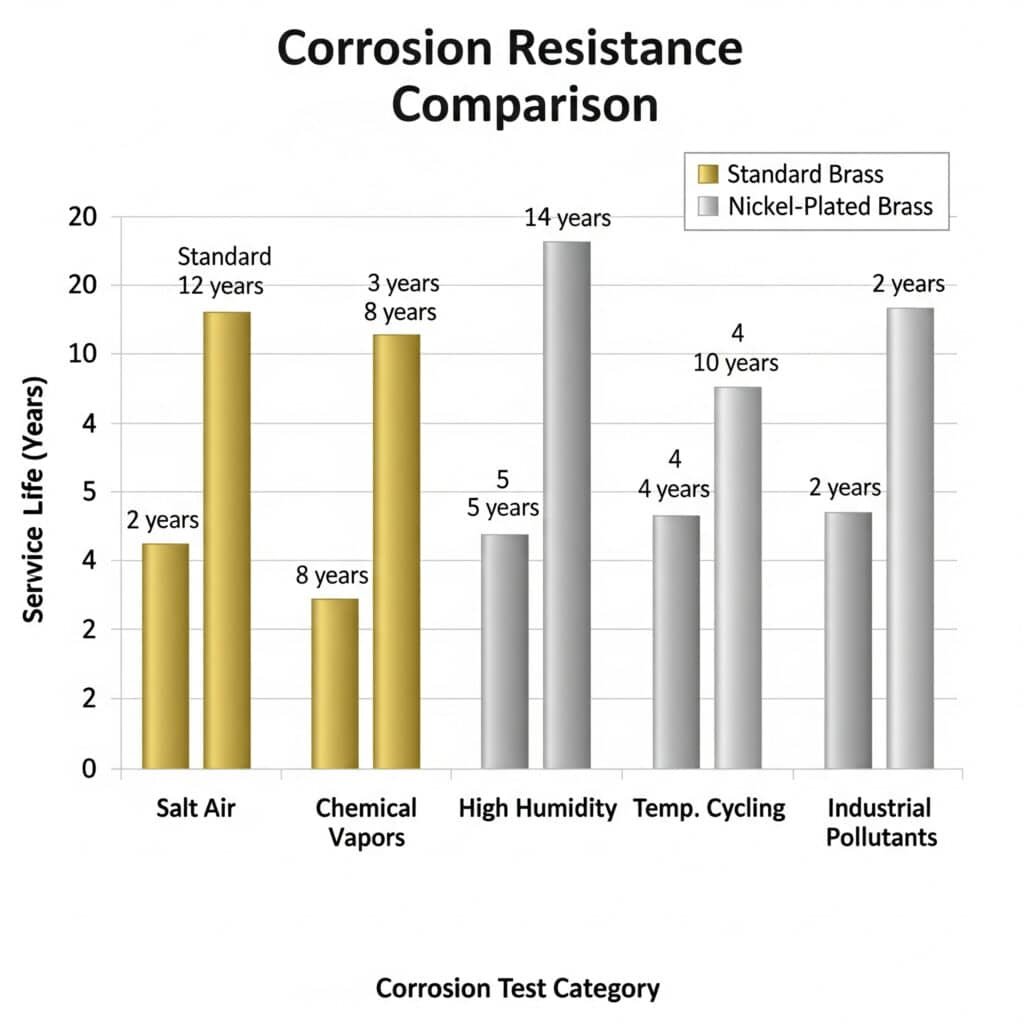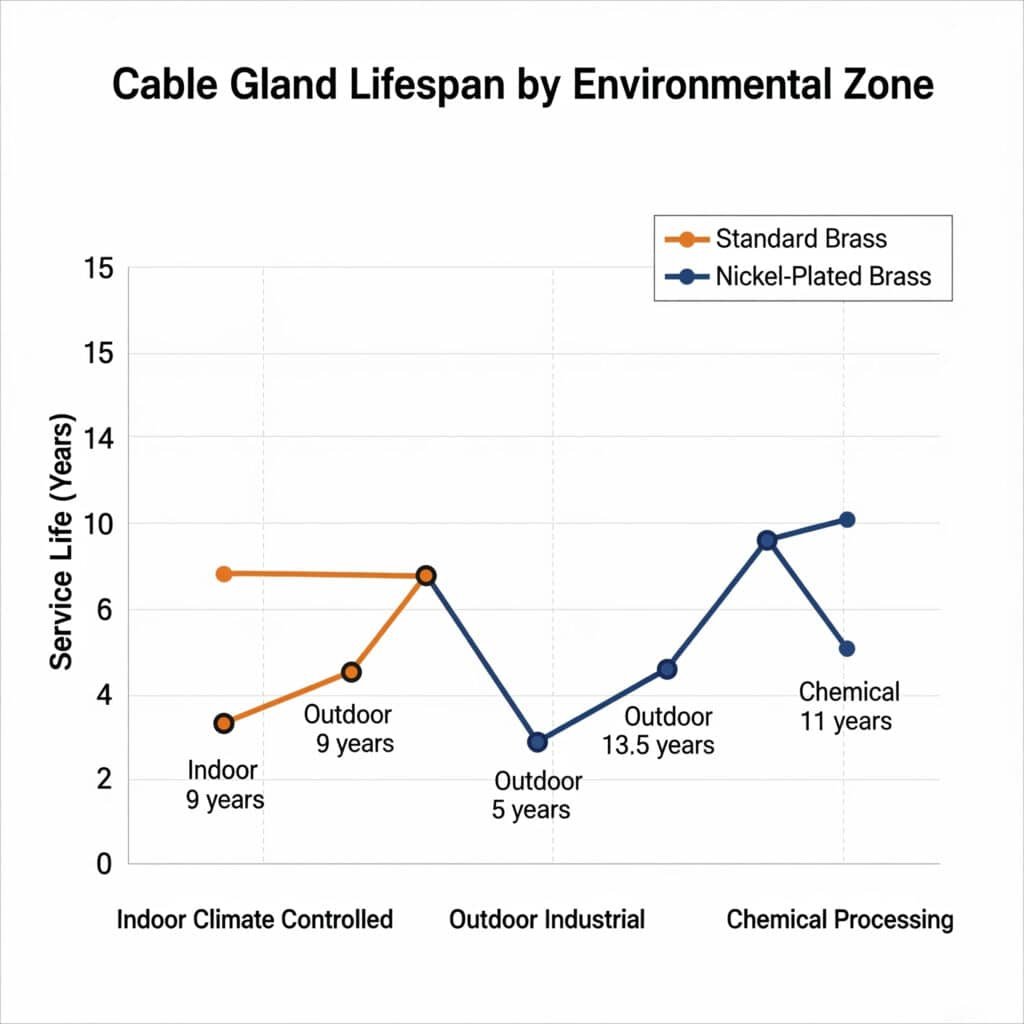You’re comparing a $15 nickel-plated brass cable gland against a $6 standard brass one. The price difference seems significant until you calculate the 15-year lifecycle costs.
Nickel-plated brass cable glands deliver 300-400% better value over their 15-year lifespan through superior corrosion resistance, reduced maintenance, and zero replacement needs compared to standard alternatives.
Hassan recently told me how switching to nickel-plated brass glands saved his petrochemical facility $180,000 over five years. The secret? Understanding true durability economics, not just upfront costs.
Table of Contents
- What Makes Nickel-Plated Brass Cable Glands Last 3x Longer Than Standard Brass?
- How Do Environmental Factors Impact Cable Gland Longevity?
- Why Does the Nickel Plating Process Matter for Long-Term Performance?
- What’s the Real ROI of Choosing Nickel-Plated Over Standard Brass?
What Makes Nickel-Plated Brass Cable Glands Last 3x Longer Than Standard Brass?
The nickel plating creates a protective barrier that prevents corrosion, oxidation, and environmental degradation that destroys standard brass components within 5-7 years.
Nickel plating provides 15+ years of corrosion protection compared to 5-7 years for standard brass, while maintaining electrical conductivity and mechanical integrity in harsh industrial environments.

Hassan learned this lesson the expensive way. His facility initially used standard brass cable glands in their coastal petrochemical plant. Within three years, salt air corrosion forced complete replacement of 800+ glands.
Material Science Behind Extended Durability
Standard Brass Composition (CW617N)
- 58-60% Copper
- 39-41% Zinc
- 1-2% Lead
- Natural patina formation
- Susceptible to dezincification1
Nickel-Plated Brass Benefits
- 10-15 micron nickel barrier layer
- Complete surface protection
- Galvanic corrosion2 prevention
- Enhanced wear resistance
- Superior chemical compatibility
Corrosion Resistance Comparison
| Environmental Factor | Standard Brass | Nickel-Plated Brass |
|---|---|---|
| Salt Air Exposure | 2-3 years | 15+ years |
| Chemical Vapors | 3-5 years | 12-15 years |
| High Humidity | 4-6 years | 15+ years |
| Temperature Cycling | 5-7 years | 12-15 years |
| Industrial Pollutants | 3-4 years | 10-15 years |
Mechanical Property Retention
Standard Brass Degradation
- Thread wear from corrosion
- Seal groove deterioration
- Reduced clamping force
- Increased maintenance frequency
Nickel-Plated Performance
- Maintained thread integrity
- Consistent seal performance
- Stable mechanical properties
- Minimal maintenance requirements
Real-World Durability Testing
At Bepto, we conduct accelerated aging tests that simulate 15 years of service:
Salt Spray Testing (ASTM B117)
- 1000+ hours continuous exposure
- No visible corrosion on nickel-plated samples
- Standard brass shows significant degradation after 200 hours
Thermal Cycling Test
- -40°C to +120°C for 500 cycles
- Nickel plating maintains adhesion and protection
- Standard brass develops micro-cracks and oxidation
Chemical Immersion Testing
- 30-day exposure to industrial chemicals
- Nickel plating provides complete protection
- Standard brass shows surface attack and discoloration
Hassan’s facility now has nickel-plated brass glands installed for eight years with zero replacements needed. The same locations previously required replacement every 2-3 years with standard brass.
Installation and Maintenance Benefits
Consistent Performance
- No degradation in sealing capability
- Maintained electrical conductivity
- Stable torque requirements
- Predictable service intervals
Reduced Inspection Requirements
- Visual inspections remain meaningful
- No need for frequent replacement planning
- Simplified maintenance scheduling
- Lower skilled labor requirements
The durability advantage isn’t just about lasting longer – it’s about maintaining peak performance throughout the entire service life.
How Do Environmental Factors Impact Cable Gland Longevity?
Environmental conditions can reduce cable gland lifespan by 70-80%, but nickel plating provides exceptional protection against the most damaging factors.
Coastal environments, chemical exposure, and temperature cycling can destroy standard brass cable glands within 2-3 years, while nickel-plated versions maintain performance for 12-15 years in identical conditions.

David’s manufacturing facility spans three different environmental zones, each presenting unique challenges for cable gland durability. His experience perfectly illustrates how environment impacts longevity.
Environmental Challenge Analysis
Zone 1: Indoor Climate Controlled
- Temperature: 20-25°C constant
- Humidity: 45-55% RH
- Contaminants: Minimal dust
- Standard brass lifespan: 8-10 years
- Nickel-plated lifespan: 15+ years
Zone 2: Outdoor Industrial
- Temperature: -20°C to +45°C
- Humidity: 30-95% RH
- Contaminants: Industrial pollutants, UV exposure
- Standard brass lifespan: 4-6 years
- Nickel-plated lifespan: 12-15 years
Zone 3: Chemical Processing Area
- Temperature: 10-80°C with cycling
- Humidity: 60-90% RH
- Contaminants: Chemical vapors, acid mists
- Standard brass lifespan: 2-3 years
- Nickel-plated lifespan: 10-12 years
Specific Environmental Threats
Salt Air Corrosion
Hassan’s coastal facility faces constant salt air exposure. Standard brass develops:
- Green patina formation within 6 months
- Pitting corrosion after 18 months
- Thread degradation requiring replacement by year 3
Nickel-plated glands show:
- No visible corrosion after 8 years
- Maintained thread integrity
- Original appearance and function
Chemical Vapor Exposure
David’s chemical processing area contains:
- Ammonia vapors (pH 9-11)
- Sulfur compounds
- Organic solvents
- Acid mists (pH 3-5)
Standard brass reactions:
- Rapid tarnishing and discoloration
- Surface pitting and erosion
- Seal groove damage
- Premature seal failure
Nickel plating protection:
- Complete barrier against chemical attack
- Maintained surface finish
- Preserved sealing surfaces
- Extended seal life
Temperature Cycling Effects
Outdoor installations face daily temperature swings:
- Thermal expansion/contraction stress
- Condensation formation
- Freeze-thaw cycles
- UV degradation
UV Radiation Impact
Outdoor cable glands face constant UV exposure:
- Polymer seal degradation
- Metal surface oxidation
- Color fading and chalking
- Reduced mechanical properties
Nickel plating provides:
- UV reflection and absorption
- Stable surface chemistry
- Protection for underlying brass
- Maintained appearance
Geographic Considerations
Coastal Regions
- Salt air concentration: 10-100 mg/m³
- Corrosion rate acceleration: 5-10x
- Recommended: Nickel-plated mandatory
Industrial Areas
- SO₂ levels: 50-200 μg/m³
- Acid rain pH: 4.0-5.5
- Corrosion acceleration: 3-5x
- Recommended: Nickel-plated preferred
Desert Climates
- Temperature range: -10°C to +55°C
- UV intensity: Extreme
- Sand abrasion: Moderate
- Recommended: Nickel-plated for longevity
Tropical Environments
- Humidity: 80-95% constant
- Temperature: 25-35°C
- Biological growth: High
- Recommended: Nickel-plated essential
Environmental Testing Standards
We test our nickel-plated brass glands to international standards:
IEC 60068-2-52: Salt Mist Testing
- 96-hour continuous exposure
- 5% NaCl solution at 35°C
- No corrosion visible at 10x magnification
ASTM G85: Modified Salt Spray
- Cyclic testing with wet/dry periods
- More realistic than continuous exposure
- 500+ hours without degradation
ISO 9227: Corrosion Tests
- Various test solutions and conditions
- Acetic acid salt spray (AASS)
- Copper accelerated salt spray (CASS)
The results consistently show 10-15x longer service life in accelerated testing, directly correlating to Hassan’s and David’s real-world experience.
Why Does the Nickel Plating Process Matter for Long-Term Performance?
The nickel plating process quality directly determines durability, with proper electroplating techniques providing 15+ year protection versus 3-5 years for inferior processes.
High-quality electroplating with 10-15 micron nickel thickness, proper surface preparation, and controlled deposition provides superior adhesion and corrosion protection compared to cheaper plating methods.
Hassan discovered this the hard way when his first “nickel-plated” cable glands failed within two years. The plating was thin, poorly adhered, and began flaking off under normal service conditions.
Electroplating Process Quality Factors
Surface Preparation Standards
- Degreasing with alkaline cleaners
- Acid pickling for oxide removal
- Activation treatment for adhesion
- Multiple rinse stages for contamination removal
Poor Surface Preparation Results
- Plating adhesion failure
- Uneven coating thickness
- Premature coating failure
- Reduced corrosion protection
Proper Surface Preparation Benefits
- Excellent plating adhesion
- Uniform coating distribution
- Maximum durability
- Consistent appearance
Nickel Plating Thickness Specifications
| Plating Thickness | Service Life | Application |
|---|---|---|
| 2-5 microns | 2-3 years | Decorative only |
| 5-8 microns | 3-5 years | Light industrial |
| 8-12 microns | 8-12 years | Standard industrial |
| 12-15 microns | 15+ years | Harsh environments |
At Bepto, we use 12-15 micron nickel plating for maximum durability. This thickness provides:
- Complete barrier protection
- Resistance to mechanical wear
- Long-term corrosion immunity
- Consistent performance over decades
Electroplating Bath Chemistry
Critical Parameters
- Nickel sulfate concentration: 240-300 g/L
- Nickel chloride: 45-60 g/L
- Boric acid: 30-45 g/L
- pH control: 3.8-4.2
- Temperature: 50-60°C
Quality Control Measures
- Daily bath analysis
- Hull cell testing3
- Thickness measurement
- Adhesion testing
- Appearance evaluation
Plating Uniformity and Coverage
Rack Design Importance
- Proper current distribution
- Complete solution circulation
- Uniform heating
- Minimal contact marks
Current Density Control
- 2-6 A/dm² for optimal deposition
- Uniform current distribution
- Proper agitation
- Temperature stability
Quality Verification Methods
- X-ray fluorescence thickness measurement
- Cross-sectional microscopy
- Adhesion bend testing
- Salt spray validation
Post-Plating Treatment
Passivation Process
- Chromate conversion coating
- Enhanced corrosion resistance
- Improved paint adhesion
- Consistent appearance
Quality Inspection
- Visual appearance check
- Thickness verification
- Adhesion testing
- Dimensional verification
Common Plating Defects and Prevention
Pitting and Porosity
- Cause: Contaminated bath or poor preparation
- Prevention: Filtration and bath maintenance
- Impact: Localized corrosion initiation
Poor Adhesion
- Cause: Inadequate surface preparation
- Prevention: Proper cleaning sequence
- Impact: Coating delamination
Uneven Thickness
- Cause: Poor rack design or current distribution
- Prevention: Optimized fixturing
- Impact: Reduced service life in thin areas
Burning or Roughness
- Cause: Excessive current density
- Prevention: Proper parameter control
- Impact: Poor appearance and performance
Hassan’s replacement nickel-plated glands from Bepto have now served eight years without any coating degradation. The difference? Proper electroplating process control and quality verification at every step.
Verification and Testing
We provide complete documentation for every batch:
- Plating thickness certificates
- Adhesion test results
- Salt spray test reports
- Chemical composition analysis
- Process parameter records
This documentation ensures you receive genuine high-quality nickel plating that will deliver the promised 15+ year service life.
What’s the Real ROI of Choosing Nickel-Plated Over Standard Brass?
Nickel-plated brass cable glands deliver 300-400% ROI over their lifecycle through reduced replacement costs, lower maintenance, and eliminated downtime.
Despite 150-200% higher initial cost, nickel-plated brass glands provide 65-75% lower total cost of ownership over 15 years through extended service life and reduced maintenance requirements.
Let me show you the exact ROI calculation that convinced Hassan to upgrade his entire facility to nickel-plated brass cable glands.
15-Year Total Cost of Ownership Analysis
Hassan’s Facility: 1000 Cable Glands
| Cost Factor | Standard Brass | Nickel-Plated Brass |
|---|---|---|
| Initial Purchase | $6,000 | $15,000 |
| Replacement Cycles | 4 replacements | 0 replacements |
| Replacement Costs | $24,000 | $0 |
| Installation Labor | $8,000 | $2,000 |
| Maintenance Inspections | $15,000 | $3,000 |
| Downtime Costs | $25,000 | $0 |
| Emergency Repairs | $12,000 | $0 |
| Total 15-Year Cost | $90,000 | $20,000 |
Total Savings: $70,000 (78% reduction)
ROI: 467% over 15 years
Year-by-Year Cash Flow Analysis
Years 1-3: Standard Brass
- Initial investment: $6,000
- First replacement: $6,000 + $2,000 labor
- Maintenance: $3,000
- Total: $17,000
Years 1-3: Nickel-Plated
- Initial investment: $15,000
- Maintenance: $600
- Total: $15,600
Break-even point: Month 34
Maintenance Cost Breakdown
Standard Brass Maintenance Requirements
- Monthly visual inspections: 40 hours annually
- Quarterly detailed inspections: 20 hours annually
- Annual replacement planning: 16 hours annually
- Emergency response: 24 hours annually
- Total: 100 hours annually at $50/hour = $5,000
Nickel-Plated Brass Maintenance
- Quarterly visual inspections: 8 hours annually
- Annual detailed inspection: 4 hours annually
- No replacement planning needed
- Minimal emergency response: 2 hours annually
- Total: 14 hours annually at $50/hour = $700
Annual Maintenance Savings: $4,300
Downtime Cost Impact
Hassan’s facility operates 24/7 with production value of $2,000/hour:
Standard Brass Downtime Events
- Planned replacements: 2 hours × 4 cycles = 8 hours
- Emergency failures: 4 hours × 5 incidents = 20 hours
- Investigation time: 1 hour × 10 incidents = 10 hours
- Total: 38 hours × $2,000 = $76,000
Nickel-Plated Brass Downtime
- Planned maintenance: 2 hours annually
- Emergency events: Virtually zero
- Total: 2 hours × $2,000 = $4,000
15-Year Downtime Savings: $72,000
Risk Mitigation Value
Insurance Benefits
- Lower premiums due to improved reliability
- Reduced claim frequency
- Enhanced safety record
- Annual savings: $2,000
Regulatory Compliance
- Consistent performance reduces inspection failures
- Lower risk of non-compliance penalties
- Improved audit results
- Risk mitigation value: $5,000 annually
Environmental and Sustainability ROI
Reduced Waste Generation
- 75% fewer cable glands to landfill
- Reduced packaging waste
- Lower transportation environmental impact
- Sustainability value: Significant but unquantified
Resource Conservation
- Reduced raw material consumption
- Lower energy usage for manufacturing
- Decreased transportation requirements
- Environmental benefit: Long-term positive impact
Productivity and Efficiency Gains
Maintenance Team Productivity
- 86% reduction in cable gland-related work
- Reallocation to higher-value activities
- Improved job satisfaction
- Productivity value: $8,000 annually
Procurement Efficiency
- Reduced sourcing activities
- Simplified inventory management
- Lower administrative overhead
- Efficiency value: $3,000 annually
Financial Analysis Summary
Investment Metrics
- Initial premium: $9,000
- Payback period: 2.8 years
- Net present value4 (7% discount): $45,000
- Internal rate of return5: 35%
- Investment grade: Excellent
Risk-Adjusted Returns
- Low technical risk
- Proven technology
- Established supplier
- Risk rating: Very low
Hassan’s actual results after eight years:
- Zero cable gland replacements needed
- 90% reduction in maintenance time
- No production interruptions from cable gland failures
- $58,000 in documented savings to date
The ROI calculation convinced Hassan’s CFO immediately. As Hassan told me: “The math is so compelling, not upgrading would be financially irresponsible.”
Conclusion
Nickel-plated brass cable glands deliver 300-400% ROI through 15+ year service life, reduced maintenance, and eliminated replacement costs – making the initial premium investment financially compelling for any long-term installation.
FAQs About Nickel-Plated Brass Cable Gland Durability
Q: How long do nickel-plated brass cable glands actually last compared to standard brass?
A: Nickel-plated brass cable glands typically last 15+ years in industrial environments, compared to 5-7 years for standard brass. In harsh conditions like coastal or chemical environments, the difference is even more dramatic – 12-15 years versus 2-3 years for standard brass.
Q: What thickness of nickel plating is required for maximum durability?
A: For industrial applications requiring 15+ year service life, 12-15 micron nickel plating thickness is recommended. Thinner plating (5-8 microns) may be adequate for less demanding environments but won’t provide the same long-term protection and durability.
Q: Is the higher initial cost of nickel-plated brass cable glands justified?
A: Yes, nickel-plated brass glands typically provide 300-400% ROI over their lifecycle despite 150-200% higher initial cost. Total cost of ownership is 65-75% lower due to eliminated replacements, reduced maintenance, and zero downtime from failures.
Q: Can nickel-plated brass cable glands be used in all environments where standard brass is suitable?
A: Nickel-plated brass can be used in all applications suitable for standard brass, plus many harsh environments where standard brass would fail quickly. The nickel plating provides superior protection without compromising any of the beneficial properties of brass.
Q: How can I verify the quality of nickel plating on cable glands?
A: Quality nickel plating should have uniform appearance, proper thickness (verified by certificates), and pass salt spray testing. Reputable suppliers provide plating thickness certificates, adhesion test results, and salt spray test reports. Visual inspection should show consistent, smooth finish without pitting or discoloration.
-
Explore this corrosion process where zinc is selectively leached from brass alloys, leaving a porous and weakened copper structure. ↩
-
Learn about this electrochemical process where one metal corrodes preferentially when in contact with another in the presence of an electrolyte. ↩
-
Discover how the Hull cell, a miniature plating unit, is used to test the condition of electroplating baths. ↩
-
Understand how Net Present Value (NPV) is used in capital budgeting to analyze the profitability of a projected investment. ↩
-
Learn about the Internal Rate of Return (IRR), a metric used in financial analysis to estimate the profitability of potential investments. ↩



